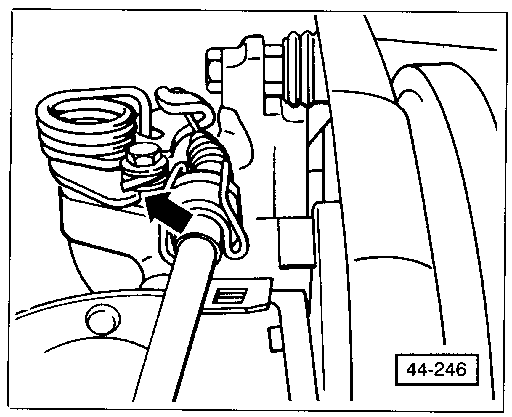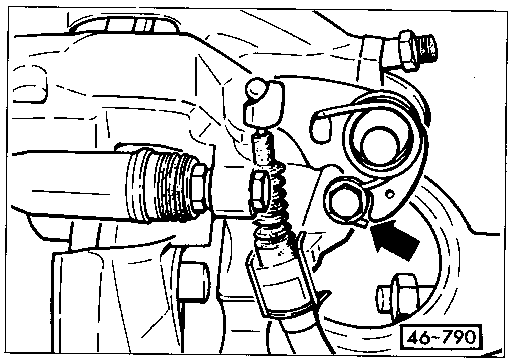Adjusting Parking Brake
The parking brake should only have to be adjusted if the cable, the brake rotor, the brake caliper, or brake pads are replaced. Failure of the brake to hold the car most likely indicates worn brake pads or a faulty caliper. Check to see that the parking brake functions properly whenever the cables have been detached for rear brake service.
CAUTION-
If adjusting the parking brake cables following work on the rear disc brakes, first adjust the brakes by retracting the caliper pistons and pumping the brake pedal to reset the automatic adjustment, as described in Removing and Installing Rear Brake Pads.
|
To adjust:
| 1. | Raise the rear of the car and support it securely on jack stands. Remove the rear wheels. Make sure the parking brake is fully released (lever down). |
| 2. | Loosen the parking brake cable locknuts and adjusting nuts under the parking brake lever just until tension on the cables is relieved. The cable attachment to the lever mechanism is shown earlier in Fig. 6-7. |
NOTE-
The actuator levers on the calipers should be against their stops, as shown in Fig. 7-8 or Fig. 7-9. If not, then the caliper's automatic adjustment mechanism may be faulty.
|
| Fig. 7-8. | Early-type rear disc brake caliper showing actuator lever resting against stop (arrow). |

|
| Fig. 7-9. | Later-type rear disc brake caliper showing actuator lever resting against stop (arrow). |

|
| 3. | Set and release the parking brake three times to stretch and seat the cables. |
| 4. | Tighten the adjusting nuts evenly so that the actuator levers at the calipers just start to lift off their stops. |
NOTE-
When the parking brake is applied, the following conditions should be met: at the first detent (one click) the rear rotors should turn by hand with slight drag; at the second detent the rotors should turn only with much effort; at the third detent it should not be possible to turn the rotors by hand. When the parking brake is released, the rotors should again turn freely.
|
| 5. | Check the gaps between the actuator levers and the stops on the calipers. On early-type calipers, the gap should be no more than 1.0 mm (.039 in.). On later-type calipers, the gap should be no more that 1.5 mm (.059 in.). If the gaps are too large, loosen the cable adjusting nuts in 1/2-turn steps until the gap is correct. |
| 6. | Tighten the parking brake cable locknuts. Mount the wheels and install the wheel lug bolts finger-tight. Lower the car to the ground and torque the lug bolts to 110 Nm (81 ft. lb.). |
|

